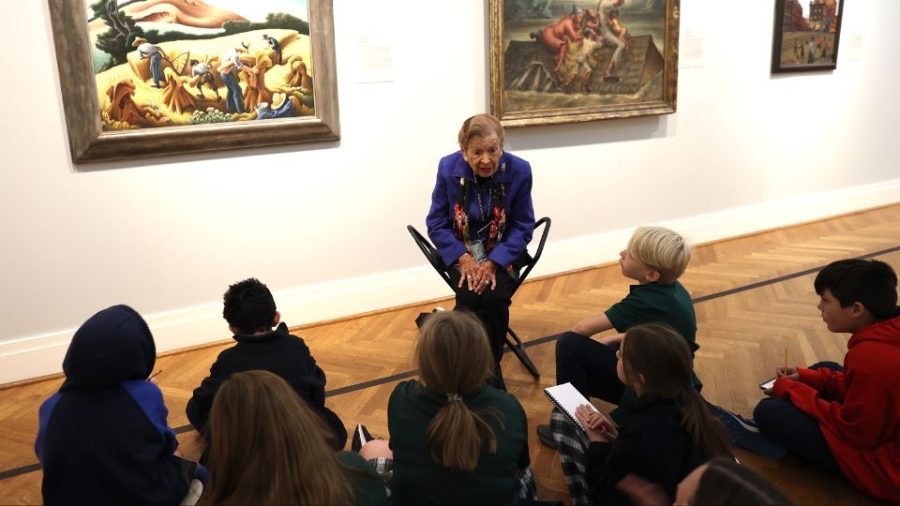It’s all about the story, and Judith Garfinkel sure has one to tell
Longtime St. Louis Art Museum docent Judith Garfinkel speaks to fourth and fifth graders from Imperial, Mo. on Oct. 19. Photo by Bill Motchan
Published November 20, 2022
As hard as I try, there is no way to describe Judith Garfinkel’s command over her young charges at the St. Louis Art Museum other than to say she had them eating out of her hand.
There she was, all 5 feet, 105 pounds of her, impeccably dressed, red lipstick perfectly applied, perched on a portable stool in front of Thomas Hart Benton’s “Cradling Wheat” masterpiece. Seated cross-legged at her feet, the fourth- and fifth-graders from St. Joseph School in Imperial listened intently, seemingly mesmerized by her every word.
At Garfinkel’s urging, some sketched parts of the painting in unlined black notebooks they had received a week earlier when they came for the first of a two-part museum visit.
“Last week, we studied portraits and looked at faces,” Garfinkel said to the children. “Faces aren’t as important in this painting. It’s what the people are doing. What time of year do you think it is?”
One boy tentatively answered: “Umm, warm, maybe summertime?”
“That’s right,” Garfinkel said. “It’s harvest. You can see the three men and the boy with their shirtsleeves rolled up working hard, harvesting the grain.”
Related:
Garfinkel is 92 and has been a docent at the art museum for 61 years, leading tours once, twice and sometimes three times a week. “Cradling Wheat” is one of her favorite paintings and is among several she has chosen for this week’s lesson, paintings that tell stories. She says she’s more interested in having the children connect with the work through the story it tells rather than have them memorize facts and figures about the art.
“Judith is able to captivate students like no other docent. She can take the rowdiest kids and huddle them up, and they will be captivated for an hour and a half. It’s amazing. She knows what she’s doing but, more importantly, she loves what she is doing,” said Adria Brown, associate educator of the docent program and gallery teaching at SLAM. “She’s the longest serving and oldest docent in our program, but she is young in spirit.”
Direction to her day
Garfinkel, who lives independently in a Clayton condo and still drives to the places she needs to go, explains that activities like being a docent provide “direction to her day” as well as a sense of purpose and connection. She got involved with the museum’s docent program when it first started.
“A friend told me about this program that was brand new,” she recalled. “So I showed up for an interview. My friend did not. She never became a docent, and I never stopped.”
Garfinkel played tennis into her 80s, stopping not because of her age or having had both knees replaced (at the same time!) in her 60s, but because she felt “unbalanced” when she played after recovering from kidney cancer surgery and chemotherapy. She continued to play golf until a few years ago when her golf partner passed away. She still exercises daily, either using the treadmill and/or stationary bike in her building’s gym or, on nice weather days, walking.
“Since the pandemic, I figure I’ve walked to Chicago and back,” she joked, adding that one of her favorite walks is down Hanley Road to Wydown Boulevard, past her former home on Alexander Drive, where she raised her three children, each of whom continues to live in Clayton. She also has seven grandchildren ranging in age from 9 to 37.
Garfinkel, who belongs to Temple Emanuel, is twice widowed. Both of her husbands died of brain tumors, the first when she had two children ages 3 and 5 at home, and the second, Dr. Bernard Garfinkel, after 40 years of marriage (together they had a third child, and Bernard adopted the older two). She also had “two lovely gentleman friends” in the years following her husband’s death in 2005, but both have since passed away.
Would she be interested in dating again?
“If someone were looking for me, but I’m not doing the looking,” she quipped, adding, “but I don’t think there are too many men my age out there looking.”
‘Age is just a number’
Garfinkel, who grew up in Clayton, graduated from Northwestern University, where she majored in children’s theater. She directed a children’s theater group in St. Louis for two years called the Peter Pan Players and then ran Miss Judy’s nursery school at the Church of the Holy Communion, the Episcopalian church with the red door, in University City.
“I was supposed to be teaching children from the church, but not one showed up,” she remembered. “My brother, who was older than me, had a lot of friends with 3- and 4-year-olds. So there I was at the Church of the Holy Communion teaching all these nice little Jewish children. It was like a fairytale.”
She stopped teaching when she decided to have a family but never lost her desire to volunteer and stay busy. For 10 years, along with the art museum, she was a docent at the Missouri Botanical Gardens and the Repertory Theatre of St. Louis. She still paints with watercolors (“oils are too hard to clean up”), plays bridge regularly and knits. Since the pandemic, she’s knitted 12 afghan blankets for family and friends.
“Age is just a number” is one of her favorite expressions, and she’s living proof. Her daughter Joanne Iskiwitch says that at Clayton High, her mother was an acrobatic cheerleader.
“When she was close to 80, she told us she could do a cartwheel and stand on her head,” Iskiwitch said. “She went ahead and did it. She never ceases to amaze us.”
Of course, living into one’s 90s is not all cartwheels and headstands. She’s racked up her share of “dramatic surgeries,” as she calls them, including an exceedingly complicated procedure to remove a tumor on the adrenal gland. She prefers to focus on the positive but mentions that she is a breast cancer survivor, having undergone a lumpectomy, chemotherapy and radiation.
“She always says to the doctor, ‘Just tell me what to do and I’ll do it,’ ” Iskiwitch said. “She stays so positive, even in the face of adversity. She sees the glass more than half full, and she really tries to befriend everyone. I think she’s met half the city of Clayton on her walks. She’s the kind of person who never knows a stranger.”
Engaging with energy and heart
Garfinkel takes her docent work very seriously. On days she leads tours, she gets to the museum in plenty of time to meet the students at the door when they arrive. She explains that the process of becoming a docent takes a couple of years, though even now she is still expected to attend lectures, tour new exhibitions and take classes to grow her knowledge.
Her ability to connect with youngsters is evident, as she encourages the children from St. Joseph’s to think hard about the stories each painting tells. She also takes time and care to review each of their sketches.
“We love her. She has taught us so much,” said St. Joe’s fifth-grade teacher April Pieper. “She engages the kids with so much energy and heart.”
While not all the tours Garfinkel leads are successful — “I had one last week where the teacher wasn’t interested and the kids didn’t take their coats off” — most go very well, she’s happy to report. She prefers leading tours for grade-school children over older students and adults.
“I’m a little more relaxed with people who are more my height,” she said with a sly smile, “though I’m noticing fifth-graders are a lot taller than they used to be.”


















